
Cepheus is a lunar impact crater that is located in the northeastern part of the Moon, within one crater diameter of the larger crater Franklin to the southeast. To the north-north-east is the flooded crater Oersted. The proximity of this formation to the lunar limb means it appears oblong when viewed from the Earth due to foreshortening.
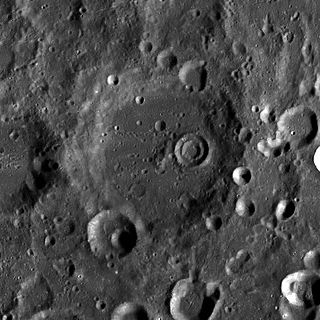
Bell is a lunar impact crater that is located on the far side of the Moon, just past the western limb. It lies in an area of terrain that is marked by many small craters, a number of which are satellite craters of Bell listed in the table below. Bell lies within two crater diameters of Laue to the north, and to the west of the smaller Helberg.

Bečvář is a lunar impact crater that is located near the equator on the far side of the Moon. It lies to the northeast of the crater Necho, within that feature's ray system. To the north-northeast is the crater Gregory.

Bouguer is a lunar impact crater that lies along the southern edge of the Mare Frigoris, to the north of the crater Bianchini. To the west-southwest of Bouguer, along the same shore of the mare, is the crater Foucault. Nearly due west is the more prominent Harpalus, and to the west is La Condamine.

Bredikhin is a lunar impact crater that is located on the far side of the Moon. It lies just to the west of the crater Mitra, and northeast of Raimond.

Buffon is a lunar impact crater that is located on the southern hemisphere on the far side of the Moon. It lies a crater diameter south of the large walled plain Chebyshev. To the northeast is the crater Langmuir and to the southwest is Leavitt. Buffon lies nearly at the midpoint between these formations.
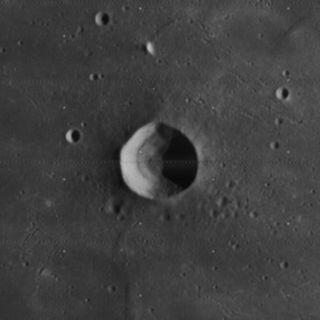
Kirch is a small lunar impact crater in the eastern part of the Mare Imbrium, a large lunar mare in the northwest quadrant of the Moon. It was named after German astronomer Gottfried Kirch. This is a relatively solitary formation with the nearest comparable crater being Piazzi Smyth to the northeast. Notable features in the vicinity are the Montes Spitzbergen mountains to the south and the solitary peak Mons Piton to the east-northeast. Kirch is circular and bowl-shaped, with a dark interior having the same albedo as the surrounding terrain.

Focas is a small lunar impact crater that lies on the far side of the Moon, just past the southwestern limb. In this location the crater is occasionally brought into view due to libration, but not much detail can be seen because the crater is viewed from the side.
Lagrange is a lunar impact crater that is attached to the northwestern rim of the crater Piazzi. It lies near the southwestern limb of the Moon, and the appearance is oblong due to foreshortening. To the northwest of this feature is the Montes Cordillera, a ring-shaped mountain range that surrounds the immense Mare Orientale impact basin.

Carver is a lunar impact crater that is located on the far side of the Moon, due east of the walled plain Van der Waals. To the northeast is the crater Rosseland, and to the south-southeast lies Kozyrev.

Chang Heng is a lunar impact crater that is located on the Moon's far side. It lies less than one crater diameter to the northeast of the walled plain Fleming. The rim of this crater is somewhat eroded, with a pair of small craters along the northern rim and tiny craters along the south and east edges. The interior floor contains a small, concentric crater that is about one third the diameter of Chang Heng. The crater is named after Chinese astronomer Zhang Heng.

Fourier is a lunar impact crater that is located in the southwestern part of the Moon's near side, just to the southeast of the crater Vieta. To the northeast is the Mare Humorum. The rim of this crater is roughly circular, but appears oval when viewed from the Earth due to foreshortening.
Piazzi is an impact crater that is located near the southwestern limb of the Moon, and is attached to the southeastern rim of the walled plain Lagrange. About three crater diameters to the south is the crater Inghirami. Piazzi is seen at an oblique angle from the Earth, and it appears oblong due to foreshortening.

Denning is a lunar impact crater that is located on the far side of the Moon. It lies about midway between the craters Levi-Civita to the south and Marconi to the north-northeast. About two crater diameters to the southeast is the huge walled plain Gagarin.
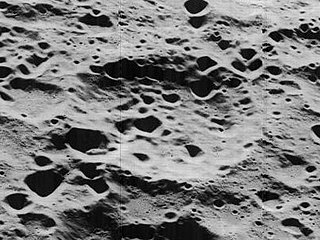
Dunér is an old lunar impact crater that is located in the northern hemisphere on the far side of the Moon. It lies to the southeast of the crater Chernyshev, and west-southwest of the Perkin–Debye crater pair.
Eijkman is a lunar impact crater that is located on the far side of the Moon's southern hemisphere. It lies about a half crater diameter to the southeast of the larger crater Lemaître. To the south-southwest is the crater Crommelin, and to the northeast is Fizeau.

Fesenkov is a lunar impact crater on the far side of the Moon. It is located to the east-southeast of the prominent crater Tsiolkovskiy, and less than a crater diameter to the north of Stark.

Kepinski is a lunar impact crater on the Moon's far side. It lies to the northwest of the larger crater Vernadskiy, and northeast of Meggers. Its name comes from Polish astronomer Felicjan Kępiński.
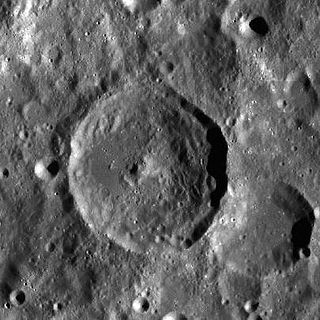
Krasovsky is an impact crater on the far side of the Moon. It is located about three crater diameters to the north-northwest of Daedalus. It is otherwise relatively isolated from impact craters of note, with the nearest comparable feature being Tiselius to the west-northwest.
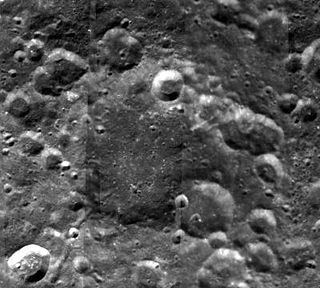
Von Békésy is a worn lunar impact crater on the far side of the Moon. It is located in the northern latitudes, behind the northeastern limb of the Moon as seen from the Earth. This is a relatively isolated crater formation, the closest named crater being Volterra, just over one crater diameter to the north-northeast. To the southwest lies Millikan.




















